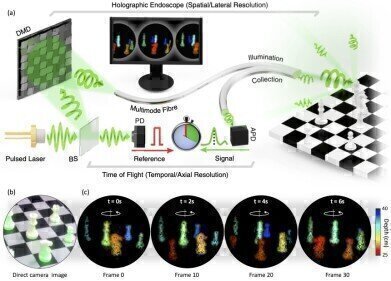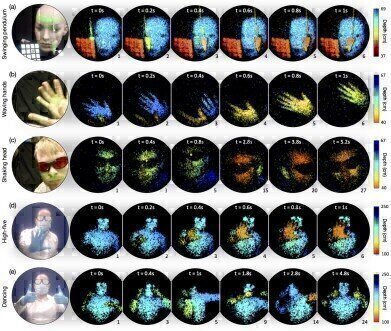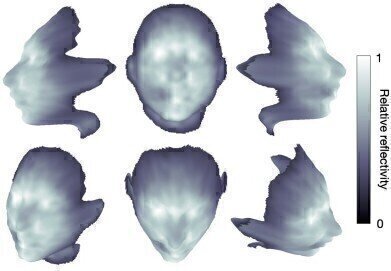-
 Figure 1: Endoscopic LiDAR. (a) A schematic of the experimental set-up. (b) A snapshot of the true scene being recorded. (c) Typical depth-resolved images obtained with the endoscope system. Each frame is captured in 200 ms. The frames show the pieces on a revolving chess board located at a depth of approx. 30 cm, recorded at a frame rate of 5Hz.
Figure 1: Endoscopic LiDAR. (a) A schematic of the experimental set-up. (b) A snapshot of the true scene being recorded. (c) Typical depth-resolved images obtained with the endoscope system. Each frame is captured in 200 ms. The frames show the pieces on a revolving chess board located at a depth of approx. 30 cm, recorded at a frame rate of 5Hz. -
 Figure 2: Snapshots from depth resolved movies at progressively increasing scene depths. Left hand column shows a direct camera image of each scene. In these images, scene depth is encoded in the colour channels, and scene reflectivity is encoded in the transparency channel. The relative time is given at the top of each frame.
Figure 2: Snapshots from depth resolved movies at progressively increasing scene depths. Left hand column shows a direct camera image of each scene. In these images, scene depth is encoded in the colour channels, and scene reflectivity is encoded in the transparency channel. The relative time is given at the top of each frame. -
 Figure 3: 3D imaging with enhanced fidelity. A series of views of a 3D reconstruction of a mannequin head located at a range of 30 cm. Here, depth is represented as the surface profile, and reflectivity is rendered as the surface shading. The data for this reconstruction were acquired in 2 s.
Figure 3: 3D imaging with enhanced fidelity. A series of views of a 3D reconstruction of a mannequin head located at a range of 30 cm. Here, depth is represented as the surface profile, and reflectivity is rendered as the surface shading. The data for this reconstruction were acquired in 2 s.
News & Views
Single Fibre Imaging holds huge potential for 3D Viewing
Jan 19 2022
International scientists led by the University of Glasgow’s Optics Group has been able to create video images from a single multimode optical fibre using time-of-flight 3D imaging.
Professor Miles Padgett, Royal Society Research Professor at the University of Glasgow and Principal Investigator for QuantIC the UK Hub for Quantum Enhanced Imaging, said: “In applications like endoscopy and boroscopy imaging is traditionally achieved by using a bundle of optical fibres, one fibre for every pixel in the image, resulting in devices the thickness of a finger.
“As an alternative, we are developing a new technique for imaging through a single fibre the width of a human hair. Our ambition is to create a new generation of single-fibre imaging devices that can produce 3D images of remote scenes.”
He also hoped that the project would generate new connections, highlighting possible end users of the technology being developed.
Normally, when light shines through a single optical fibre, crosstalk between modes scrambles the light to make the image unrecognisable. To resolve this, the team use advanced beam shaping techniques to pattern the input laser light to the fibre to create a single spot at the output. That spot of light then scans over the scene and the system measures the intensity of the backscattered light into another fibre - giving the brightness of each pixel in the image.
By using a pulsed laser, they also measure the time of flight of the light and hence the range of every pixel in the image. These 3D images can be recorded at distances from a few tens of millimetres to several metres away from the fibre end with millimetric distance resolution and frame rates high enough to perceive motion at close to video quality.
The prototype system delivers images through a 40 cm long optical fibre at 5 Hz, each frame containing up to approximately 4000 independently resolvable features, with a depth resolution of ∼5 mm. Currently the multimode fibre must remain in a fixed position after calibration.
Future research will look at reducing the calibration time and managing the dynamic nature of bending fibres. The team aim to work with industry to develop this world-changing research into functional technology within the next ten years.
The project is a collaboration between physicists at the University of Glasgow, University of Exeter, Fraunhofer Centre for Applied Photonics Glasgow, Leibniz Institute of Photonic Technology Germany and Brno University of Technology Czech Republic.
The research was supported by funding from Engineering and Physical Sciences Research Council (EPSRC), UK National Quantum Technology Programme (UKNQTP), European Research Council (ERC), Royal Academy of Engineering and the Royal Society.
‘Time-of-flight 3D imaging through multimode optical fibres’, is published in Science.
More information online
Digital Edition
Lab Asia 31.2 April 2024
April 2024
In This Edition Chromatography Articles - Approaches to troubleshooting an SPE method for the analysis of oligonucleotides (pt i) - High-precision liquid flow processes demand full fluidic c...
View all digital editions
Events
Apr 22 2024 Marrakech, Morroco
Making Pharmaceuticals Exhibition & Conference
Apr 23 2024 Coventry, UK
Apr 23 2024 Kintex, South Korea
Apr 23 2024 Seoul, South Korea
Apr 24 2024 Jakarta, Indonesia



.jpg)













